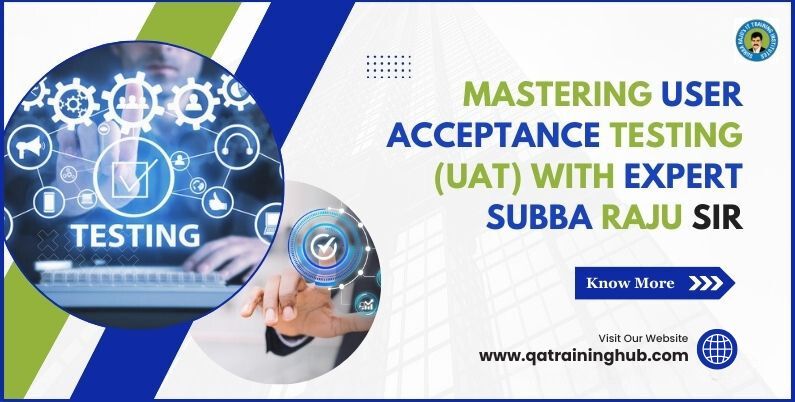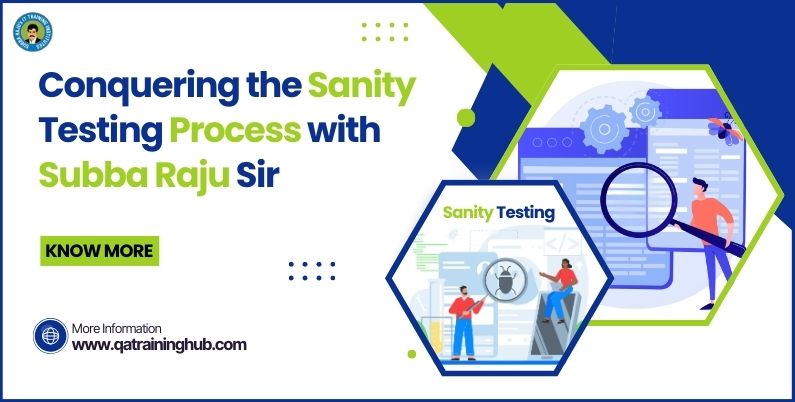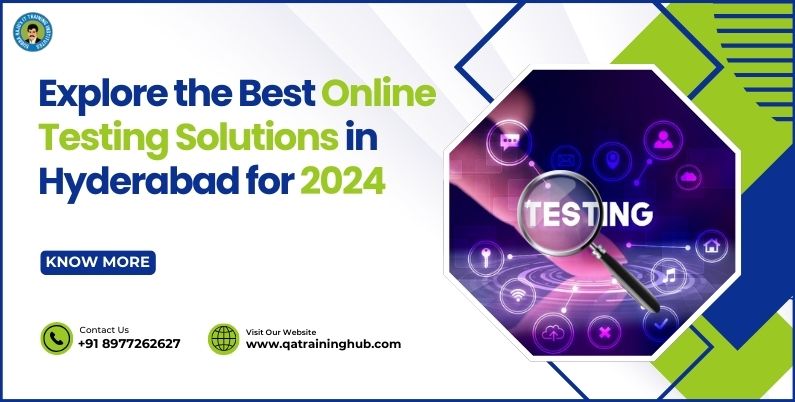
QA Training Hub, led by the experienced Subba Raju Sir, offers specialized training in various types of software testing to ensure aspiring QA professionals are industry-ready. Whether you are a beginner or looking to enhance your testing skills, our QA testing classes in Hyderabad provide a robust platform to learn and excel. In the dynamic world of software development, quality assurance (QA) serves as a cornerstone for delivering reliable, high-performing applications. QA is not just about finding bugs; it’s about ensuring the software meets all functional and performance requirements while providing a seamless user experience. To thrive in this domain, it’s essential to master various testing methodologies.
At QA Training Hub, we are dedicated to nurturing proficient QA professionals who are well-versed in the latest testing techniques and tools. Under the expert guidance of Subba Raju Sir, a veteran in the field, our training programs are designed to cover a wide spectrum of testing types, ensuring a holistic learning experience. Whether you are starting your career or seeking to specialize in a specific area of QA, our QA testing classes in Hyderabad are tailored to meet diverse learning needs.
At QA Training Hub the emphasize if given mainly for the practical learning, Subba Raju sir provides hands on session, live projects and real world case studies. The practical approach will be very much useful for the students to understand the testing concepts and will also be useful in the challenges of a rapidly evolving software industry.
Types of Testing Provided by QA Training Hub
1 Manual Testing: The Foundation of QA
Manual testing is a fundamental aspect of software quality assurance. It involves manually executing test cases without the use of automation tools to identify bugs and ensure the software behaves as expected. This method focuses on the user experience, functionality, and overall system stability, making it a critical step in the software development lifecycle.
Key Elements of Manual Testing:
- Understanding Requirements:
Testers thoroughly analyze software requirements to create comprehensive test cases. This helps in covering all possible scenarios, ensuring the application is tested from every angle. - Test Case Design and Execution:
Testers design and execute test cases manually, focusing on different aspects like functionality, usability, and edge cases. This helps in identifying issues that might not be easily detected through automated testing. - Defect Identification and Reporting:
Any discrepancies between expected and actual behavior are reported as defects. Testers document these findings meticulously to help developers resolve them efficiently. - Exploratory and Ad-hoc Testing:
Manual testing allows for exploratory testing, where testers can intuitively explore the application to uncover hidden bugs. Ad-hoc testing, conducted without predefined test cases, helps in finding unexpected issues. - User Experience Assessment:
By manually interacting with the software, testers can provide valuable feedback on the user experience, ensuring the application is intuitive and user-friendly.
2. Test Automation
Test automation is essential for improving efficiency and accuracy in the testing process. At QA Training Hub, we equip students with the skills to use popular automation tools to write scripts that automate repetitive test cases.
Key elements of Test automation
1. Automation Tools Selection
- Choosing the Right Tools: The selection of appropriate automation tools depends on the project requirements, application type, and technology stack. Popular tools include Selenium for web applications, QTP/UFT for functional testing, and JUnit/TestNG for unit testing.
- Tool Compatibility: Ensure the chosen tools are compatible with the application under test, the development environment, and the CI/CD pipeline.
2. Test Automation Framework
- Framework Design: A well-structured framework is the backbone of any successful automation effort. Frameworks like data-driven, keyword-driven, and hybrid provide a standardized approach to writing and executing test cases.
- Reusability and Maintenance: A good framework promotes reusability of test scripts and simplifies maintenance, reducing the overall cost of testing.
3. Test Script Development
- Script Creation: Writing clear and concise test scripts that align with the test cases and business requirements. This often involves using programming languages like Java, Python, or C#.
- Modularization: Breaking down test scripts into smaller, reusable modules enhances script readability and maintainability.
4. Test Data Management
- Data-Driven Testing: Automation often involves testing with multiple sets of data. Managing this data efficiently is crucial for validating different scenarios and ensuring comprehensive test coverage.
- Data Security: Protecting sensitive test data and ensuring compliance with data privacy regulations.
5. Reporting and Analysis
- Detailed Reporting: Automation frameworks should provide detailed test reports, including pass/fail status, error logs, and execution times, to help identify issues quickly.
- Result Analysis: Analyzing test results to pinpoint root causes of failures and optimize the testing process.
3. Database Testing
Database testing ensures the integrity and security of data within software applications. This testing checks the data stored in the backend databases for correctness and reliability.
Key Elements of Database Testing
Database testing is a crucial aspect of software quality assurance, focusing on validating the integrity, accuracy, and performance of databases. It ensures that data handling processes within an application work as expected, including data storage, retrieval, and manipulation. Here are the key elements of database testing:
1. Data Integrity Testing
- Ensuring Consistency: Verifying that the data remains consistent across the database, even after various operations such as insertions, deletions, and updates.
- Data Accuracy: Ensuring that data is accurately stored, retrieved, and manipulated, reflecting the intended values and relationships.
2. Data Validation Testing
- Input Data Validation: Checking if the data being entered into the database meets the defined validation rules, such as format, type, and constraints.
- Output Data Validation: Ensuring the correctness of data retrieved from the database, including reports, queries, and stored procedures.
3. Database Schema Testing
- Schema Structure Validation: Verifying that the database schema, including tables, columns, indexes, and keys, is correctly implemented as per the design specifications.
- Constraints Testing: Ensuring that constraints such as primary keys, foreign keys, and unique constraints are properly enforced, maintaining data integrity.
4. Performance Testing
- Query Performance: Evaluating the efficiency of database queries, ensuring they execute within acceptable time limits and handle large datasets effectively.
- Load Testing: Assessing the database’s ability to handle concurrent user access and high transaction loads without performance degradation.
5. Stored Procedures and Triggers Testing
- Functionality Testing: Verifying the functionality of stored procedures and triggers, ensuring they execute correctly and produce the desired outcomes.
- Error Handling: Checking for proper error handling mechanisms within stored procedures and triggers to manage unexpected scenarios gracefully.
Why Database Testing is Critical
Database testing is crucial for maintaining the reliability and performance of any application that heavily relies on data. At QA Training Hub, we provide comprehensive training in database testing under the expert guidance of Subba Raju Sir. Our QA testing classes in Hyderabad equip students with practical knowledge and hands-on experience, ensuring they can effectively perform all aspects of database testing in real-world scenarios.

4. Protocol Testing
Protocol testing involves testing various communication protocols to ensure data is transmitted accurately between systems. This type of testing is crucial for networking and telecommunications industries.
Key Elements of Protocol Testing
Protocol testing is a specialized area of software testing that focuses on verifying communication protocols in networking devices such as routers, switches, and firewalls. It ensures that data is transmitted accurately, securely, and efficiently across networks. Here are the key elements of protocol testing:
1. Protocol Specification Understanding
- Protocol Standards: Familiarity with industry-standard protocols like TCP/IP, HTTP, FTP, SNMP, and others is crucial. Testers must understand the rules and conventions that define how data is transmitted and received.
- Layer-Specific Testing: Protocols operate at different layers of the OSI or TCP/IP model, such as application, transport, and network layers. Testing must be tailored to the specific layer and its functions.
2. Interoperability Testing
- Compatibility Testing: Ensuring that different devices and software implementing the protocol can work together seamlessly.
- Cross-Vendor Compatibility: Verifying that devices from different manufacturers can communicate effectively using the same protocol.
3. Conformance Testing
- Compliance with Standards: Ensuring that the protocol implementation adheres strictly to the defined standards and specifications.
- Error Handling: Testing how the system behaves when it encounters protocol deviations, errors, or malformed packets.
4. Performance Testing
- Latency and Throughput: Measuring the delay in data transmission and the amount of data that can be transferred over the network in a given time.
- Stress Testing: Evaluating the protocol’s performance under heavy load conditions, including high traffic volumes and multiple simultaneous connections.
5. Security Testing
- Data Encryption and Integrity: Ensuring that the protocol securely encrypts data during transmission and maintains data integrity.
- Authentication and Authorization: Testing mechanisms for verifying user identities and ensuring proper access control.
- Vulnerability Testing: Identifying and mitigating potential security weaknesses or exploits within the protocol implementation.
Importance of Protocol Testing
Protocol testing is essential for ensuring the reliability, security, and efficiency of communication in networked systems. At QA Training Hub, we offer specialized training in protocol testing, led by the expert Subba Raju Sir. Our QA testing classes in Hyderabad provide hands-on experience with industry-standard tools and techniques, preparing students to excel in the rapidly evolving field of network protocol testing.
5. Cloud Testing
With the growing adoption of cloud technologies, cloud testing has become vital. It involves testing the software’s functionality, performance, and security in a cloud environment.
Key Elements of Cloud Testing
Cloud testing involves validating the performance, security, scalability, and reliability of applications hosted on cloud environments. It ensures that cloud-based applications meet the expected standards and function optimally across various scenarios. Here are the key elements of cloud testing:
1. Environment Testing
- Multi-Tenancy Testing: Ensuring that multiple users or tenants can share the cloud infrastructure without affecting each other’s data or performance.
- Environment Configuration: Validating the cloud environment’s configuration settings, including network, storage, and compute resources, to ensure optimal performance and reliability.
- Cross-Environment Compatibility: Testing the application across different cloud platforms (AWS, Azure, Google Cloud) to ensure compatibility and performance.
2. Performance Testing
- Load Testing: Simulating high traffic conditions to evaluate how the application handles peak loads in the cloud environment.
- Stress Testing: Pushing the application beyond its capacity limits to understand its breaking point and recovery capabilities.
- Scalability Testing: Assessing how the application scales under increased workload or user demand, utilizing the cloud’s elastic nature.
3. Security Testing
- Data Security and Privacy: Ensuring that sensitive data is encrypted, protected, and complies with regulatory standards like GDPR, HIPAA, or PCI-DSS.
- Access Control and Authentication: Verifying that user access is properly restricted and managed using identity and access management (IAM) policies.
- Vulnerability Testing: Identifying potential security loopholes or vulnerabilities within the cloud application and infrastructure.
4. Functionality Testing
- Feature Validation: Testing all functionalities of the application in the cloud environment to ensure they operate as intended.
- Integration Testing: Ensuring seamless integration between the cloud-based application and other services, APIs, or third-party systems.
- Regression Testing: Re-validating functionality after updates or changes to ensure no new issues have been introduced.
5. Disaster Recovery and Business Continuity
- Backup and Restore Testing: Verifying that data backups are properly created and can be restored accurately in case of data loss.
- Failover Testing: Testing the cloud infrastructure’s ability to automatically recover from failures, ensuring minimal downtime and data loss.
- Redundancy Testing: Ensuring redundant systems are properly configured to take over in the event of a failure, maintaining service continuity.
Importance of Cloud Testing
Cloud testing is important for organizations dealing with cloud technologies to make sure that their applications are robust, secure, and perform well under various conditions. At QA Training Hub, under the guidance of Subba Raju Sir, we provide comprehensive training in cloud testing. Our QA testing classes in Hyderabad train students with the skills to effectively test cloud-based applications, using the latest tools and procedures to meet industry demands.
Why Choose QA Training Hub?
Subba Raju Sir brings years of industry experience to the classroom, ensuring students receive practical insights and up-to-date knowledge. Our QA testing classes in Hyderabad are designed to provide comprehensive training, hands-on experience, and real-world application of testing methodologies.
Benefits of Enrolling:
- Interactive sessions with industry experts.
- Access to live projects for practical exposure.
- Certification upon completion to boost your career prospects.
Conclusion
Whether you aim to master manual testing or delve into advanced areas like cloud and protocol testing, QA Training Hub offers the expertise and resources to help you succeed. Join our QA testing classes in Hyderabad and embark on a rewarding QA career under the guidance of Subba Raju Sir.
For more details on our training programs and schedules, visit QA Training Hub today!







